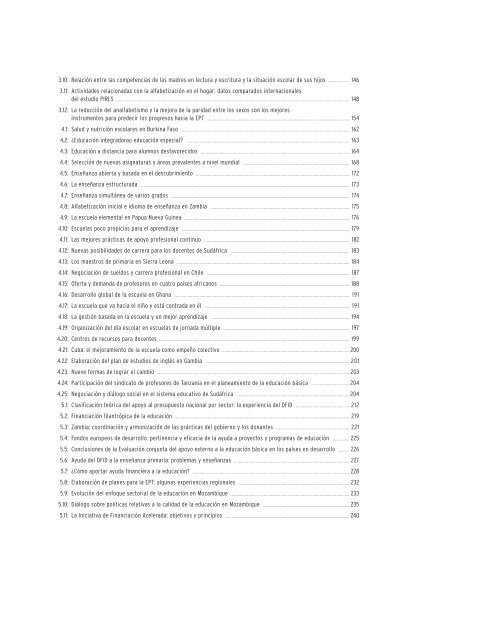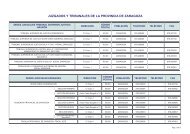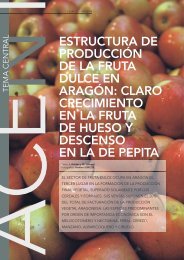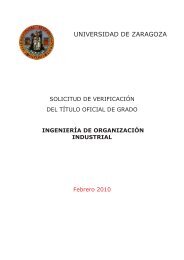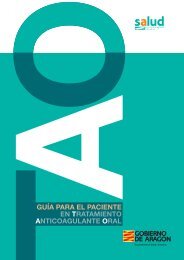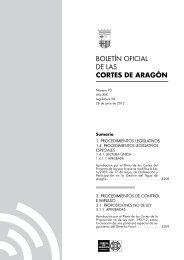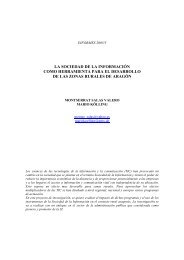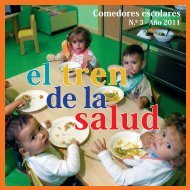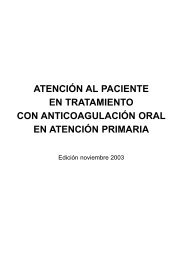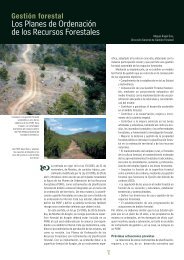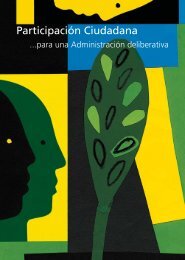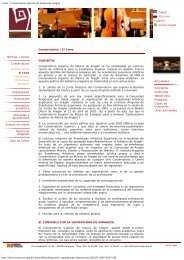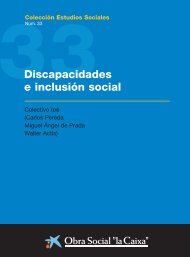Educación para todos: el imperativo de la calidad - unesdoc - Unesco
Educación para todos: el imperativo de la calidad - unesdoc - Unesco
Educación para todos: el imperativo de la calidad - unesdoc - Unesco
Create successful ePaper yourself
Turn your PDF publications into a flip-book with our unique Google optimized e-Paper software.
3.10: R<strong>el</strong>ación entre <strong>la</strong>s competencias <strong>de</strong> <strong>la</strong>s madres en lectura y escritura y <strong>la</strong> situación esco<strong>la</strong>r <strong>de</strong> sus hijos . . . . . . . . . 146<br />
3.11: Activida<strong>de</strong>s r<strong>el</strong>acionadas con <strong>la</strong> alfabetización en <strong>el</strong> hogar: datos com<strong>para</strong>dos internacionales<br />
d<strong>el</strong> estudio PIRLS . . . . . . . . . . . . . . . . . . . . . . . . . . . . . . . .. . . . . . . . . . . . . . . . . . . . . . . . . . . . . . . . . . . . . . . . . . . . . . . . . . . . . . . . . . . . . . . .. . . 148<br />
3.12: La reducción d<strong>el</strong> analfabetismo y <strong>la</strong> mejora <strong>de</strong> <strong>la</strong> paridad entre los sexos son los mejores<br />
instrumentos <strong>para</strong> pre<strong>de</strong>cir los progresos hacia <strong>la</strong> EPT . . . . . . . . . . . . . . . . . . . . . . . . . . . . . . . .. . . . . . . . . . . . . . . . . . . . . . . . . . . . . 154<br />
4.1: Salud y nutrición esco<strong>la</strong>res en Burkina Faso . . . . . . . . . . . . . . . . . . . . . . . . . . . . . . . .. . . . . . . . . . . . . . . . . . . . . . . . . . . . . . . . . . . . . . . . 162<br />
4.2: ¿<strong>Educación</strong> integradorao educación especial . . . . . . . . . . . . . . . . . . . . . . . . . . . . . . . .. . . . . . . . . . . . . . . . . . . . . . . . . . . . . . . . . . . . . 163<br />
4.3: <strong>Educación</strong> a distancia <strong>para</strong> alumnos <strong>de</strong>sfavorecidos . . . . . . . . . . . . . . . . . . . . . . . . . . . . . . . .. . . . . . . . . . . . . . . . . . . . . . . . . . . . . . . 164<br />
4.4: S<strong>el</strong>ección <strong>de</strong> nuevas asignaturas y áreas prevalentes a niv<strong>el</strong> mundial . . . . . . . . . . . . . . . . . . . . . . . . . . . . . . . .. . . . . . . . . . . . . . 168<br />
4.5: Enseñanza abierta y basada en <strong>el</strong> <strong>de</strong>scubrimiento . . . . . . . . . . . . . . . . . . . . . . . . . . . . . . . .. . . . . . . . . . . . . . . . . . . . . . . . . . . . . . . . . 172<br />
4.6: La enseñanza estructurada . . . . . . . . . . . . . . . . . . . . . . . . . . . . . . . .. . . . . . . . . . . . . . . . . . . . . . . . . . . . . . . . . . . . . . . . . . . . . . . . . . . . . . . . . 173<br />
4.7: Enseñanza simultánea <strong>de</strong> varios grados . . . . . . . . . . . . . . . . . . . . . . . . . . . . . . . .. . . . . . . . . . . . . . . . . . . . . . . . . . . . . . . . . . . . . . . . . . . . 174<br />
4.8: Alfabetización inicial e idioma <strong>de</strong> enseñanza en Zambia . . . . . . . . . . . . . . . . . . . . . . . . . . . . . . . .. . . . . . . . . . . . . . . . . . . . . . . . . . . 175<br />
4.9: La escu<strong>el</strong>a <strong>el</strong>emental en Papua Nueva Guinea . . . . . . . . . . . . . . . . . . . . . . . . . . . . . . . .. . . . . . . . . . . . . . . . . . . . . . . . . . . . . . . . . . . . . . 176<br />
4.10: Escu<strong>el</strong>as poco propicias <strong>para</strong> <strong>el</strong> aprendizaje . . . . . . . . . . . . . . . . . . . . . . . . . . . . . . . .. . . . . . . . . . . . . . . . . . . . . . . . . . . . . . . . . . . . . . . 179<br />
4.11: Las mejores prácticas <strong>de</strong> apoyo profesional continuo . . . . . . . . . . . . . . . . . . . . . . . . . . . . . . . .. . . . . . . . . . . . . . . . . . . . . . . . . . . . . . 182<br />
4.12: Nuevas posibilida<strong>de</strong>s <strong>de</strong> carrera <strong>para</strong> los docentes <strong>de</strong> Sudáfrica . . . . . . . . . . . . . . . . . . . . . . . . . . . . . . . .. . . . . . . . . . . . . . . . . . . 183<br />
4.13: Los maestros <strong>de</strong> primaria en Sierra Leona . . . . . . . . . . . . . . . . . . . . . . . . . . . . . . . .. . . . . . . . . . . . . . . . . . . . . . . . . . . . . . . . . . . . . . . . . 184<br />
4.14: Negociación <strong>de</strong> su<strong>el</strong>dos y carrera profesional en Chile . . . . . . . . . . . . . . . . . . . . . . . . . . . . . . . .. . . . . . . . . . . . . . . . . . . . . . . . . . . . . 187<br />
4.15: Oferta y <strong>de</strong>manda <strong>de</strong> profesores en cuatro países africanos . . . . . . . . . . . . . . . . . . . . . . . . . . . . . . . .. . . . . . . . . . . . . . . . . . . . . . . 188<br />
4.16: Desarrollo global <strong>de</strong> <strong>la</strong> escu<strong>el</strong>a en Ghana . . . . . . . . . . . . . . . . . . . . . . . . . . . . . . . .. . . . . . . . . . . . . . . . . . . . . . . . . . . . . . . . . . . . . . . . . . 191<br />
4.17: La escu<strong>el</strong>a que va hacia <strong>el</strong> niño y está centrada en él . . . . . . . . . . . . . . . . . . . . . . . . . . . . . . . .. . . . . . . . . . . . . . . . . . . . . . . . . . . . . . 191<br />
4.18: La gestión basada en <strong>la</strong> escu<strong>el</strong>a y un mejor aprendizaje . . . . . . . . . . . . . . . . . . . . . . . . . . . . . . . .. . . . . . . . . . . . . . . . . . . . . . . . . . . 194<br />
4.19: Organización d<strong>el</strong> día esco<strong>la</strong>r en escu<strong>el</strong>as <strong>de</strong> jornada múltiple . . . . . . . . . . . . . . . . . . . . . . . . . . . . . . . .. . . . . . . . . . . . . . . . . . . . . . 197<br />
4.20: Centros <strong>de</strong> recursos <strong>para</strong> docentes . . . . . . . . . . . . . . . . . . . . . . . . . . . . . . . .. . . . . . . . . . . . . . . . . . . . . . . . . . . . . . . . . . . . . . . . . . . . . . . . . 199<br />
4.21: Cuba: <strong>el</strong> mejoramiento <strong>de</strong> <strong>la</strong> escu<strong>el</strong>a como empeño colectivo . . . . . . . . . . . . . . . . . . . . . . . . . . . . . . . .. . . . . . . . . . . . . . . . . . . . . . 200<br />
4.22: E<strong>la</strong>boración d<strong>el</strong> p<strong>la</strong>n <strong>de</strong> estudios <strong>de</strong> inglés en Gambia . . . . . . . . . . . . . . . . . . . . . . . . . . . . . . . .. . . . . . . . . . . . . . . . . . . . . . . . . . . . . 201<br />
4.23: Nueve formas <strong>de</strong> lograr <strong>el</strong> cambio . . . . . . . . . . . . . . . . . . . . . . . . . . . . . . . .. . . . . . . . . . . . . . . . . . . . . . . . . . . . . . . . . . . . . . . . . . . . . . . . . . 203<br />
4.24: Participación d<strong>el</strong> sindicato <strong>de</strong> profesores <strong>de</strong> Tanzania en <strong>el</strong> p<strong>la</strong>neamiento <strong>de</strong> <strong>la</strong> educación básica . . . . . . . . . . . . . . . . 204<br />
4.25: Negociación y diálogo social en <strong>el</strong> sistema educativo <strong>de</strong> Sudáfrica . . . . . . . . . . . . . . . . . . . . . . . . . . . . . . . .. . . . . . . . . . . . . . . . 204<br />
5.1: C<strong>la</strong>sificación teórica d<strong>el</strong> apoyo al presupuesto nacional por sector: <strong>la</strong> experiencia d<strong>el</strong> DFID . . . . . . . . . . . . . . . . . . . . . . . 212<br />
5.2: Financiación fi<strong>la</strong>ntrópica <strong>de</strong> <strong>la</strong> educación . . . . . . . . . . . . . . . . . . . . . . . . . . . . . . . .. . . . . . . . . . . . . . . . . . . . . . . . . . . . . . . . . . . . . . . . . . 219<br />
5.3: Zambia: coordinación y armonización <strong>de</strong> <strong>la</strong>s prácticas d<strong>el</strong> gobierno y los donantes . . . . . . . . . . . . . . . . . . . . . . . . . . . . . . . 221<br />
5.4: Fondos europeos <strong>de</strong> <strong>de</strong>sarrollo: pertinencia y eficacia <strong>de</strong> <strong>la</strong> ayuda a proyectos y programas <strong>de</strong> educación . . . . . . . 225<br />
5.5: Conclusiones <strong>de</strong> <strong>la</strong> Evaluación conjunta d<strong>el</strong> apoyo externo a <strong>la</strong> educación básica en los países en <strong>de</strong>sarrollo . . . . . 226<br />
5.6: Ayuda d<strong>el</strong> DFID a <strong>la</strong> enseñanza primaria: problemas y enseñanzas . . . . . . . . . . . . . . . . . . . . . . . . . . . . . . . .. . . . . . . . . . . . . . . . . 227<br />
5.7: ¿Cómo aportar ayuda financiera a <strong>la</strong> educación . . . . . . . . . . . . . . . . . . . . . . . . . . . . . . . .. . . . . . . . . . . . . . . . . . . . . . . . . . . . . . . . . . . 228<br />
5.8: E<strong>la</strong>boración <strong>de</strong> p<strong>la</strong>nes <strong>para</strong> <strong>la</strong> EPT: algunas experiencias regionales . . . . . . . . . . . . . . . . . . . . . . . . . . . . . . . .. . . . . . . . . . . . . . . 232<br />
5.9: Evolución d<strong>el</strong> enfoque sectorial <strong>de</strong> <strong>la</strong> educación en Mozambique . . . . . . . . . . . . . . . . . . . . . . . . . . . . . . . .. . . . . . . . . . . . . . . . . . . 233<br />
5.10: Diálogo sobre políticas r<strong>el</strong>ativas a <strong>la</strong> <strong>calidad</strong> <strong>de</strong> <strong>la</strong> educación en Mozambique . . . . . . . . . . . . . . . . . . . . . . . . . . . . . . . .. . . . . 235<br />
5.11: La Iniciativa <strong>de</strong> Financiación Ac<strong>el</strong>erada: objetivos y principios . . . . . . . . . . . . . . . . . . . . . . . . . . . . . . . .. . . . . . . . . . . . . . . . . . . . . 240


